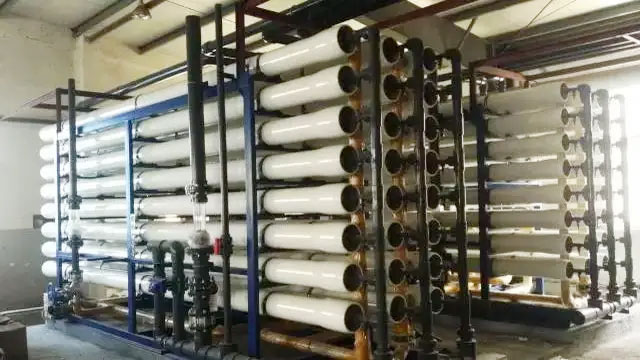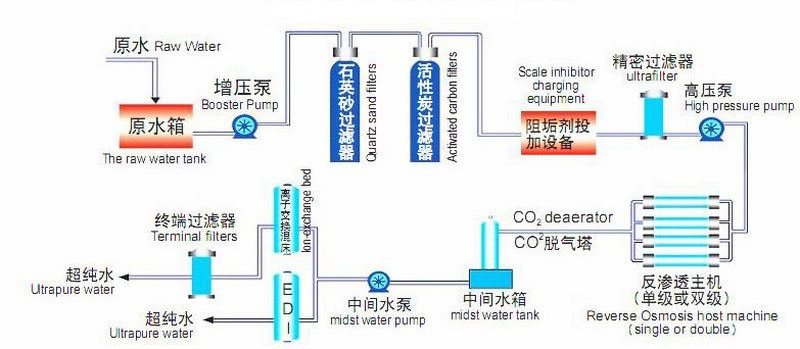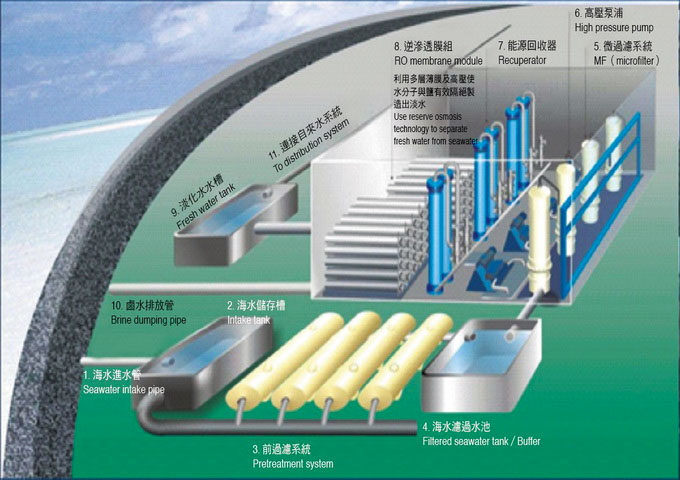Desalination of seawater with reverse osmosis has grown rapidly. UltraClean looks at tools to address the ongoing challenge of membrane fouling.
Water use has been growing at more than twice the rate of population increase in the past century. The combination of economic and demographic growth in particular has led to over-abstraction of conventional freshwater resources in various parts of the world. With this, we have seen an increase in water scarcity, considered to be when the total annual runoff available for human use is less than 1000m3/capita/year.
There are several technical solutions that can help to solve water scarcity around the world: saving water by, for example, increasing efficiency in agriculture and industry, reducing leakage in public water supply, or implementing progressive tariffs to reduce consumption; transporting water, which normally requires transport over long distances, potentially with high energy costs; storing river water in aquifers during periods of high flow; reusing water in industry and agriculture; or desalting brackish water, wastewater effluent, and seawater.
Among the alternative solutions, desalination is usually only implemented as a last resort when conventional freshwater resources have been stretched to the limit. Yet, the continuous lowering of prices and energy consumption has allowed desalination to obtain a more prominent position in water treatment options. Desalination is considered as a drought-proof water source, which does not depend on river flows, reservoir levels or climate change. Moreover, megacities, where water demand is typically high, are very often situated on the coast, where desalination fits perfectly.

The installed capacity for desalination of seawater and brackish water has grown rapidly over the past 30 years. Global capacity is now more than 100 million cubic metres per year, helping satisfy the growing municipal, agricultural and industrial water demand. Desalination capacity is expected to double by 2030. Currently, about 330 million people in the world receive drinking water from desalination plants (at 120l/p/d).
Globally, 53% (54Mm3/d) of desalination capacity is sited in the countries of the Middle East and North Africa, 16% (16Mm3/d) in East Asia and Pacific countries, 10% (9.9Mm3/d) in North America, 8% (8Mm3/d) in Western Europe, 6% (5.7Mm3/d) in Latin America and Caribbean countries, 3% (3.7Mm3/d) in Southern Asia, 2% (1.8Mm3/d) in Sub-Saharan Africa, and 2% (2.2Mm3/d) in Eastern Europe and Central Asia.
Seawater is the main water source for desalination in all regions, with the exception of North America, where the regional capacity is based on brackish water desalination (73%/7.3Mm3/d), followed by wastewater effluent (19%/1.9Mm3/d). Japan, South Korea, Chinese Taiwan and China desalinate seawater, brackish water and wastewater effluent in almost equal parts.
Technology wise, membrane-based desalination with reverse osmosis (RO) dominates the market (approximately 70%). Its investment cost and energy requirements today are lower than for thermal processes (MSF and MED, 24%). The main use of desalinated water is as drinking water provision, water for industry, and water for irrigation. Most of the Middle East countries rely on desalination for municipal use, while countries such as China, India, South Korea, Brazil, Chinese Taiwan, Chile and Indonesia use desalination to satisfy industrial demand.
Some recent trends in seawater desalination with RO include: the default application of pressure recovery devices; plants of capacity > 50,000m3/day; use of larger diameter RO elements (16-inch versus 8-inch); new pre-treatment approaches for challenging feed waters (including algal blooms); application of real-time monitoring tools and sensors; application of machine learning for process optimisation; minimising the consumption of chemicals; use of satellite images for monitoring seawater quality; intermittent or shock chlorination at the intake (instead of continuous dosing); and the integration of renewable energy to drive desalination. Other improvements are related to the properties of the RO membranes, focusing on less fouling development, higher permeability while keeping a high salt rejection, tolerance to free-chlorine, and new process configurations, such as semi-batch RO and flow-reversal modes of operation.

There are already unmet needs and the prospects are that demand will grow, not least because the world population is expected to reach 9.7 billion by 2050. Combined with a more erratic and uncertain supply, this will aggravate the situation in regions that are already water-stressed, and generate water stress in regions that currently have abundant water resources.
Desalination will provide (more so than currently) an option to alleviate scarcity in industry and coastal cities, in particular. Around 680 million people currently live in low-lying coastal zones. This is expected to increase to a billion by 2050. Also, nearly 2.4 billion people live within 100km of the coast, and 65 million live in Small Island Developing States. Consequently, cities along or close to the coast may consider the use of seawater as an alternative source for drinking water production, agriculture, or industry.
Desalination is often considered too technical, too costly, too energy intensive, and limited by technical and environmental challenges. As with all drinking water technologies, desalination has its challenges and solutions to those challenges. The price per cubic metre of water has reduced significantly over the years because of more efficient membrane production, implementation of energy recovery devices, cost engineering, etc, and a larger market. Energy demand per cubic metre has already reduced, and could be brought down further by switching to renewable energy sources. Yet, membrane fouling is still the main ‘Achilles heel’ for an overall application of RO.

Fouling may result in a variety of problems – such as the need for (frequent) membrane cleaning, reduction of production capacity, higher energy consumption, and decrease in produced water quality – that it makes RO production facilities less reliable, and the need for membrane replacement more frequent.
The types of fouling are categorised into: particulate/colloidal fouling because of suspended and colloidal matter; inorganic fouling because of iron and manganese; organic fouling by organic compounds e.g., polymers; biofouling from growth of bacteria; and scaling because of deposition of sparingly soluble compounds.
Fouling and scaling may manifest in three ways, namely: increasing the differential pressure across the spacer in spiral wound elements because of ‘clogging’, resulting in potential membrane damage (such as telescoping, channelling or squeezing); increasing membrane resistance (or decreasing the normalised permeability) because of deposition and/or adsorption of materials on the membrane surface, resulting in higher required feed pressure to maintain capacity; and increasing normalised salt passage because of concentration polarisation in the fouling layer, resulting in higher salinity in the product water.
Particulate and colloidal fouling are mostly well controlled by the pre-treatment systems (mostly media filtration or membrane filtration), but the occurrence of organic fouling and biofouling is still a major issue in sea water RO (SWRO) membranes, and is the main reason for the need for frequent cleaning of the reverse osmosis membranes.
To prevent the occurrence of membrane fouling, pre-treatment in RO plants is essential. Additionally, methods and tools can help significantly, by monitoring the performance of the pre-treatment with regard to fouling control and process optimisation. Pre-treatment can take place in the form of media filters with or without coagulation, membrane filtration with or without inline coagulation (e.g., ultrafiltration), and dissolved air floatation in combination with the previous mentioned two options. Along with the increase in the number of desalination plants witnessed (reaching a cumulative total of about 21,000 plants in 2020), the capacity of the plants has increased significantly over time. We have seen a growing preference for extra-large (XL) plants (capacity >50,000 m3/d). More XL SWRO plants are expected in the future. This means reliable pre-treatment systems and monitoring tools will be essential for these XL plants, as Cleaning-in-Place (CIP) of membrane modules more than once per year is difficult.
In the next paragraphs, two examples of tools that have been developed and applied in full scale reverse osmosis plants are listed.
Particulate fouling in SWRO systems results in flux decline, higher energy costs, and increased salt passage, increased cleaning frequency and use of chemicals. An index to assess the particulate fouling potential of water can help plant operators adjust the pre-treatment to protect the membranes from receiving water with a high fouling potential. There are several indices available. Indices such as Silt Density Index (SDI) and MFI0.45 (modified fouling index with 0.45µm filters) are used, but they are determined at constant pressure of 2bar. The high constant pressure results in high initial flux rates (> 1500l/m2/h) and does not take into account the deposition of particles/colloids.
The modified fouling index with ultrafiltration membranes (MFI-UF) at constant flux operation incorporates the effects of particle deposition and flux rate and allows for a better prediction of fouling rate in RO membrane systems. The MFI-UF was developed to work with membranes of various pore sizes (5-100kDa) and flux ranges between 10-350l/m2/h. This prediction model for particulate fouling was further developed to incorporate the effects of particle deposition on the membrane surfaces and filtration flux effect during testing. Employing the new improved model, the rate of particulate/colloidal fouling potential of pre-treated seawater was found to be close to that of full-scale desalination plants (between 0.2-1bar/month), using a 10kDa membrane determined at similar flux rate to a real RO system. Being able to predict better helps in getting the right measures in place, which strongly reduces costs and prolongs membrane lifespan.